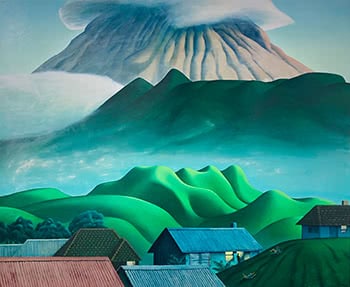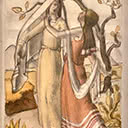Summer Evening in Taranaki, 1974
87 x 106.5 cm
PROVENANCE
Collection of film maker Tony Hiles,
Wellington
Living under the mountain on hills and land made by volcanic activity seems very risky behaviour but it is something I grew up with, regarding it as normal. p 164 Michael Smither Painter, Trish Gribben, Ron Sang Publications 2004
ILLUSTRATED
P 165 Michael Smither Painter, Trish Gribben,
Ron Sang Publications 2004
The name Michael Smither often brings to mind images of Mount Taranaki. The breadth of Smither's contribution to New Zealand art is often thought of, and reflected through his many paintings of the mountain. His identity as an artist and his work's connection to the New Zealand landscape owe much to this region where he was born, raised a family, and lived for large periods of his life. Many of his paintings of the mountain have been made available in print form, which has furthered the proliferation and recognisability of his work over the years. This was a deliberate decision on the artist's part, making his work more accessible, and helps explain why we so readily associate Smither with images of the mountain, and vice versa.
The wonderful 1970s painting Summer Evening in Taranaki conveys both the personal and epic proportions of this relationship. It is geographically and spiritually specific in its expression of Taranaki. It belongs to one of the most sought-after periods in the artist's work (and arguably the most technically important). There is brilliance in Smither's treatment of colour and in the smooth, rolling contours of the land, contrasting with the precision of the houses in the foreground. Combined with the pyramidal forms which sweep the eye towards the mountain's shrouded peak, this painting has a steady, beating heart beneath its verdant surface. As viewers, we feel like privileged onlookers.
In Smither's most well-known views of the mountain, Taranaki's classical formation is pared back to a perfectly shaped cone. The mountain's topography lends itself particularly well to strong sharp lines and modernist modulation, partly because its form is so pleasingly symmetrical. Smither experimented with depictions of this favoured subject in varying lights, moods and perspectives. In Summer Evening, it has been relegated to the top third of the painting and dominates by implication, rather than by force of presence. This time, the mountain has not been painted as a lone volcanic giant overlooking the surrounding flat land, but is partially hidden, a nestling guardian of civilisation.
The presence of homes and people in this scene breathes life into it, making it feel specific as well as timeless. Two children slide down the hill, while another person silhouetted by the backlight of a porch watches them. The suggested motion of these figures, and the transient formations of cloud embracing the mountain, cast the volcano into a state of permanence. Taranaki's etched lines appear ancient, unshakeable, and fill us with a sense of the maunga's mana and force.





